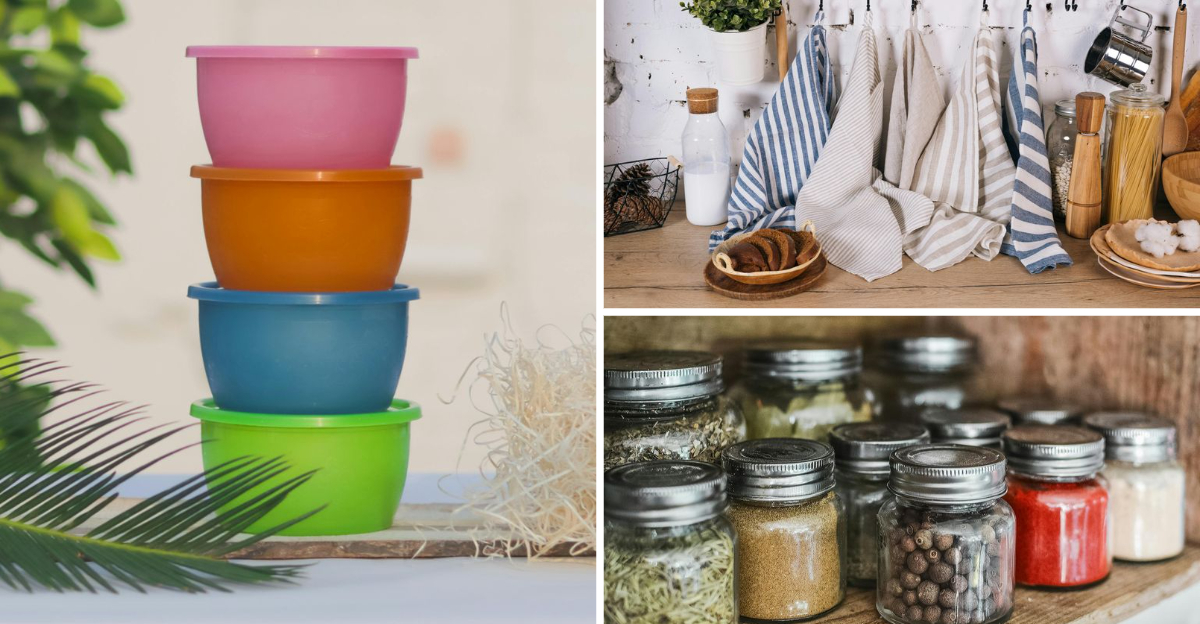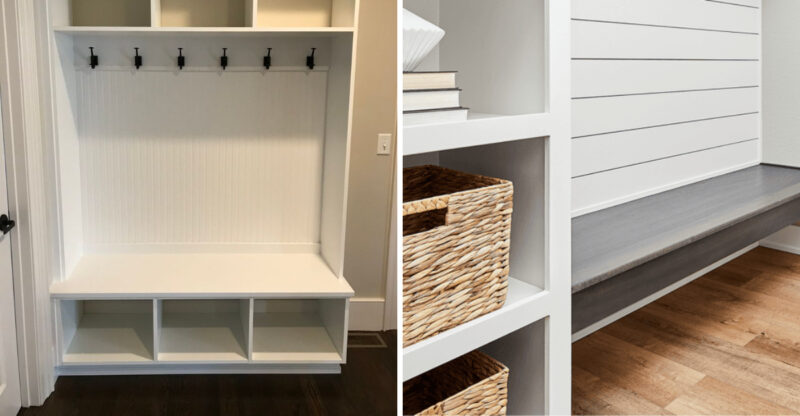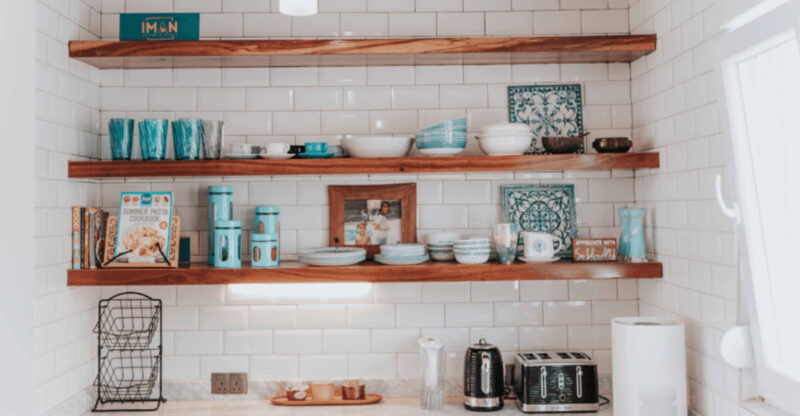11 Kitchen Items You Should Finally Toss To Free Up Space

Is your kitchen starting to feel cramped and chaotic? Those drawers that barely close and cabinets stuffed to the brim are sure signs it’s time for a cleanout.
Most of us hang onto kitchen items long past their prime, creating unnecessary clutter in one of our home’s most important spaces.
Let’s look at 11 things you can confidently toss today to reclaim your kitchen counters and storage areas. Results may vary depending on your cooking habits and how often you use certain items.
1. Old Plastic Containers
Remember those takeout containers you’ve been hoarding since 2019? They’re probably stained, warped, or missing lids by now. Plastic containers can harbor bacteria in their scratches and release chemicals when damaged.
I recently purged my own collection after realizing I had 20+ containers but only used about five regularly. The rest were just taking up valuable drawer space! If they’re stained with tomato sauce or have that perpetual greasy feel, it’s definitely time to say goodbye.
Pro tip: Keep only containers that stack neatly together with matching lids. Your future self will thank you when reaching for leftovers storage becomes less of a plastic avalanche.
2. Chipped Dishes
Those chipped plates aren’t just eyesores they’re actually health hazards. Bacteria love hiding in those little cracks, and chips can sometimes contain lead or other chemicals that might leach into food.
My grandmother always said chipped dishes bring bad luck, but I’m more concerned about the tiny ceramic fragments that might end up in my meals! When inspecting your dinnerware, hold each piece up to the light to spot hairline cracks you might have missed.
Letting go of these dishes opens up shelf space for items you’ll actually enjoy using. Plus, you don’t need to replace everything at once even a few new plates can refresh your kitchen’s look while making mealtime safer.
3. Worn-Out Cutting Boards
Deeply grooved cutting boards aren’t just difficult to clean they’re germ playgrounds! Those knife marks create perfect hiding spots for bacteria, especially if you’re cutting raw meat.
When I noticed my wooden board was developing a permanent funk despite scrubbing, I knew it was time to let go. A good rule: if your board has deep cuts that trap food particles or warps when wet, replace it immediately. Wood boards typically last 3-5 years with proper care, while plastic ones need replacing even sooner.
If you’re attached to a wooden board with minor damage, try sanding it down first. But if it’s beyond saving, composting wooden boards or recycling plastic ones is better than keeping these kitchen health risks around.
4. Dull Knives
Did you know dull knives cause more kitchen accidents than sharp ones? When a knife can’t cut properly, you apply more pressure, increasing the chance of slips and cuts.
I’ve held onto blunt knives for years thinking I’d eventually sharpen them. Truth is, if that knife has been dull for months and you haven’t fixed it yet, you probably never will! Cheap, low-quality knives that won’t hold an edge are prime candidates for replacement.
Instead of keeping a drawer full of mediocre blades, invest in just 2-3 quality knives that serve multiple purposes. Most home cooks only need a chef’s knife, paring knife, and maybe a serrated bread knife. Your cooking will become more enjoyable with tools that actually work!
5. Expired Spices
That dusty oregano from 2016? It’s not dangerous, but it’s definitely not adding flavor to your food anymore! Contrary to popular belief, spices don’t last forever they lose potency over time, leaving your cooking bland and disappointing.
Ground spices typically last 2-3 years, while whole spices might stretch to 4 years. I recently tested this by comparing fresh cinnamon to a jar I’d had for five years the difference was shocking! The old spice had almost no aroma or flavor left.
When decluttering, check dates and smell each spice. If there’s little to no scent when you crush it between your fingers, it’s time to replace it. Your taste buds will appreciate the upgrade, and you’ll free up space in that overcrowded spice rack.
6. Rusty Pots and Pans
Rust isn’t just unsightly it can actually transfer to your food during cooking. When your once-trusty pans develop those reddish-brown spots, it’s a clear signal they’ve reached the end of their useful life.
I hung onto a rusty wok for years, convincing myself it added “character.” In reality, it was just adding iron oxide to my stir-fry! Non-stick pans with scratched coatings are equally problematic since those damaged surfaces can release potentially harmful chemicals.
Quality cookware is worth the investment, but even the best pans eventually wear out. Before tossing, check if your brand offers recycling programs many manufacturers now take back old cookware for responsible disposal or materials recovery, making the parting less painful.
7. Stained Towels
Kitchen towels that look like evidence from a crime scene aren’t doing your kitchen any favors! Those permanently stained, frayed dish towels might be “still working,” but they’re likely harboring bacteria despite washing.
I used to keep discolored towels for “messy jobs,” but eventually realized having separate towel categories was creating unnecessary complexity. Most cotton kitchen towels should be replaced every 1-2 years with regular use, as even clean-looking towels can harbor germs in worn fibers.
Don’t toss those old towels in the trash though! Cut them into smaller cleaning rags for truly messy jobs, use them in the garage, or check if animal shelters in your area need cloth donations. Your kitchen deserves fresh, absorbent towels that you’re not embarrassed to have hanging on display.
8. Cracked Glassware
That favorite mug with the hairline crack isn’t worth the risk of hot coffee suddenly pouring into your lap! Cracked glassware isn’t just aesthetically unpleasant it’s actually dangerous as the damage can suddenly worsen during use.
After my husband’s beloved coffee mug finally split while holding hot liquid, we implemented a zero-tolerance policy for damaged drinkware. Thermal shock from hot beverages makes cracked items particularly vulnerable to complete failure, potentially causing burns or injuries.
Examine your glasses by holding them up to light to spot subtle cracks. Be especially vigilant with items that go from refrigerator to microwave, as temperature changes accelerate damage. While parting with sentimental pieces can be difficult, your safety is worth more than keeping that chipped college souvenir glass.
9. Mismatched Tupperware Lids
If finding matching containers and lids feels like an archaeological expedition, it’s time for a serious purge! Those orphaned lids without containers (or containers without lids) are just taking up valuable drawer space.
My personal breaking point came when I spent five frustrating minutes searching for a lid that probably hadn’t existed for years. Now I maintain a simple system: if I find a container without a matching lid, it leaves my kitchen immediately. No exceptions, no “maybe I’ll find it later.”
When rebuilding your collection, consider investing in a single matching set rather than accumulating random takeout containers. Look for stackable options with lids that attach to their matching containers for storage. Your future self will thank you when packing leftovers becomes a 10-second task instead of a frustrating treasure hunt!
10. Sticky Measuring Cups
Measuring cups and spoons with permanent residue aren’t just unpleasant to use they’re probably giving you inaccurate measurements! When sticky buildup changes the capacity of your measuring tools, your recipes suffer.
After noticing my quarter-cup measure had developed a seemingly permanent sugary film, I realized it was affecting my baking results. If soaking your measuring tools in hot, soapy water doesn’t restore them to like-new condition, replacement is the best option.
Modern measuring cups come in easy-clean materials like silicone or stainless steel that resist buildup. Some even feature measurement markings that won’t wear off over time. While it might seem wasteful to replace something that “still works,” inaccurate measuring tools actually waste ingredients by producing failed recipes a much more expensive problem in the long run!
11. Frayed Dish Brushes
If your dish brush resembles a sad, splayed paintbrush, it’s not cleaning effectively anymore. Worn brushes with bent, broken, or flattened bristles can’t reach into corners and crevices, leaving food particles behind.
My moment of truth came when I noticed my “clean” glasses still had lipstick marks after washing. Dish brushes should be replaced every 3-4 months with regular use, as they harbor bacteria in their worn bristles and handles. Sponges need even more frequent replacement ideally every 2-4 weeks!
Before tossing old brushes, consider repurposing them for cleaning grout, tight corners, or other tough cleaning jobs around the house. When buying replacements, look for options with replaceable heads to reduce waste. A fresh cleaning tool makes dishwashing more effective and pleasant something we could all use!






